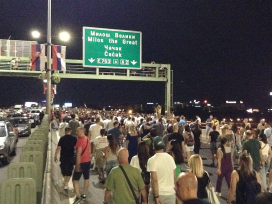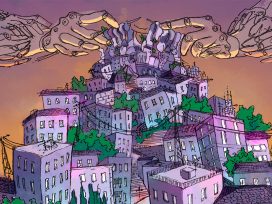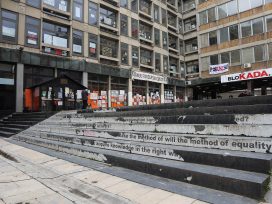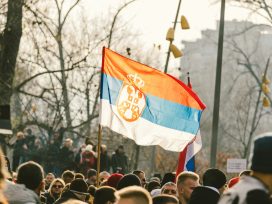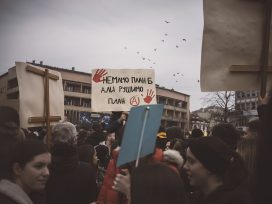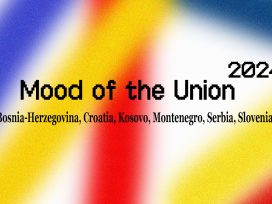On 22 September 2018, sometime around 9:30am, Aca Šimunov (41) and Stefan Dabetić (26), two construction workers, fell to their deaths while accessing the twenty-second floor of one of Belgrade’s luxury Waterfront district high-rises. Their deaths were not extraordinary events in 2018: fifty-one other workers died on their jobs that year in Serbia, a plurality of them construction workers. The Belgrade Waterfront, a 3.5-billion euro private-public partnership between the Emirati firm Eagle Hills and the Serbian government, exemplifies the city’s recent housing project construction boom. Envisioning a bright future of luxury apartments, high-rises, marinas, hotels and shopping malls, the project signals Serbia’s commitment to a post-socialist modernity circumscribed by capital.
On the surface, the Waterfront projects a vision of a-historic glass and steel, the architecture of finance capital. Its towers are almost ‘out of time’, their uninterrupted cuboids reflecting a watered-down version of the high-modernist aesthetic developed by Mies van der Rohe for midtown Manhattan in the late 1950s. Sprinkled between the high-rises are neo-futurist designs such as the 168m Kula Belgrade tower. Nothing in the Waterfront appears to have its own historical narrative. The modernist referent of its glass facades simply serves as a weakened memory, something which, in the words of Fredric Jameson, ‘serves to annihilate time’.
While many of these projects are mixed-use with significant commercial components, the majority of their square meterage comprises residential units for the real-estate market. This is for a good financial reason: average real-estate prices in Belgrade have continued to grow at a rate of 7% per year since the end of the recession in 2014. Based primarily in the premium and high-end segment of the market, such housing satisfies a growing demand in a population that has experienced easier access to bank loans and the opening of the country’s economy after the fall of Milošević. According to Deloitte and Touche, the average return on equity for the banking sector in Serbia was 11.3% in 2018. Such favourable conditions for constructing profitable luxury housing also drive speculatory investment on the part of a nascent bourgeoisie, further raising real-estate prices. Belgrade’s construction boom has thus relied on a quick turn-around of investment and conservative architectural endeavours, comprised mostly of modernist and a-historic designs.

A banner advertising the upcoming Maserati dealership, with a BW. Residences tower in the background. Photo by Miloš Jovanović.
As the largest of these projects, the Belgrade Waterfront is situated at the apex of Serbia’s long-standing ambitions to join the European family of nations. Paradoxically, its ‘end of history’ narrative relies heavily on historical comparison. Introducing the project to the National Assembly in 2015, Serbian president (then prime-minister), Aleksandar Vučić linked the Waterfront’s revitalization of the post-industrial Savamala district with nineteenth-century de-Ottomanization under Prince Miloš Obrenović (1830–39, 1858–60). In Vučić’s exposé, Belgrade’s post-Ottoman transition was a simile for Serbia’s economic transition to market capitalism. Vučić compared himself to Miloš – they had both undertaken an arduous struggle against a ‘backward people’, unwilling to step into modernity.
Such narratives of universal, capitalist progress rely on a depthless engagement with history based on a fantasy of uncontested pasts. As the Belgrade city manager Goran Vesić noted in 2017: ‘the Savamala was created thus – with the stick. A Serbian merchant town built by Miloš to oppose the Kalemegdan fortress, which remained in Turkish hands … Today, it is made with cranes, with trucks, and with machines’. Official narratives frame the two transitions – from empire to nation state and from socialism to capitalism – as nodes in one continuous progression, tellingly skipping over the entirety of Yugoslav history. And yet a more careful examination of Belgrade’s nineteenth-century history may likewise bring into focus the contradictions inherent in both post-Ottoman and post-socialist transitions.
Exploring the history of urban change in post-Ottoman Belgrade, as this article does, has the potential to illuminate the city’s post-socialist condition. Instead of a continuity of progress, juxtaposing the two temporal nodes of Savamala’s transformation reflects how global and native forms of capital fuel internal social transformation and the expansion of local accumulation through dispossession. To study these processes, their meaning and effects means to study the structure of capitalist urbanism writ small. What follows, therefore, is a historical narrative which, through its interpretative form, looks to weaponize past tensions and direct them at the present.
Restructuring Housing in post-Ottoman Belgrade
During the nineteenth century, most Balkan cities went through a process of urban transformation and modernization in conditions remarkably similar to their contemporary situation. In Serbia, the Christian merchant bourgeoisie looked to Europeanization as a way to cement their social and political leadership during the country’s autonomy from the Ottoman Empire (1830-1878) and its later independence (1878-1915). Governing elites sought to solidify temporal authority over their Christian subjects by designing judicial and fiscal institutions to replace those of the Ottoman state. In the decade after autonomy, this process resulted in the construction of new government buildings, luxury homes and a new fabric production district in the predominantly Christian neighbourhood known as the Savamala. Built on land forcibly dispossessed from local residents, these buildings relied on the knowledge of Ottoman-educated masters who had grown up with the esnaf guild system. The most prominent of these guild masters was Hadži-Nikola Živković who designed and built two Savamala konaks (Prince’s palaces) between 1829 and1831.
In the early nineteenth century, the Savamala had housed Christians and Muslims, Roma and Gadje – many of whom had escaped from large feudal estates along the Sava and Danube rivers. The neighbourhood was small. Artisans and agricultural workers, small-scale traders, porters from the nearby waterfront, day labourers, tavern proprietors and sex workers all lived in less than two hundred houses. Unlike the merchant bourgeoisie led by the autocratic reformer Prince Miloš Obrenović, these residents lost out in the transition from empire to nation-state.
Savamala’s potentially lucrative position as a stable port district on the Sava meant that it quickly gained the new authorities’ attention. After initial attempts to displace residents under police chief Cvetko Rajović failed, in 1834 the existing neighbourhood was burned to the ground over the course of two days. Describing the event in his unpublished memoirs, Sima M. Sarajlija notes that Prince Miloš, astride his horse, had given the order to burn the neighbourhood without even allowing the residents to collect their wares. The French Slavicist traveller Robert Cyprien described the event with biting sarcasm: ‘the fire, excited by the wind, rolled its blazing tongues and licked the hill, as if to purify it from the all the filth of human misery and render it worthy to receive the voluptuous villa of a prince.’ Complaints from the former Savamalans, which emerged after Prince Miloš’s downfall, confirmed their displacement in similar albeit more prosaic language. The new Savamala construction effort brought engineers and architects from Habsburg lands across the Danube and Sava. Whereas construction work had previously been led by guild craftspeople from the Ottoman South, these northern, ‘European’ men had formal, technical knowledge. As the main Savamala buildings were being completed in the mid-1830s, a Slovak Habsburg subject named Franc Janke was invited to assume the new post as Belgrade’s chief municipal engineer. One of Janke’s large-scale projects was the design of a fabric production district in the Savamala, which manifested as straight lines of multiple housing. The buildings combined residences with working quarters and exemplified a new vision for the city. Houses were no longer individual nodes connected by streets but elements in a larger vision through which social or economic activity could be reconfigured.
Aesthetics and ideology of urban housing in 19th century Belgrade
In 1846 the first aesthetic prescripts for constructing housing in Belgrade were placed and later expanded, requiring buildings to be ‘decorated’ and their frontage aligned with the street, which itself had to be straight. As a consequence, houses began to have full-frontage, street-facing facades. The regulations effectively revoked the construction of Ottoman-style Balkan houses and transformed the cityscape’s aesthetic language. The new style eradicated certain exterior forms such as protrusions into the street (çıkma) and introduced neo-classical elements such as pilasters and columns. The previous separation of a semi-public area (selamlık) and private area (haremlık) in domestic interiors was revoked by incorporating a kitchen into the main structure and introducing a new divide between servant and master quarters. Such layouts served as new physical manifestations of an individual’s role in the changing organization of social reproduction under bourgeois urbanism.
In 1850 a Serbian law established property books as centralized records of all claims to land. Importantly, the new regulation also introduced mortgages as new instruments which linked land ownership with finance capital, requiring proof of ownership to be determined by property book records. All of these developments emerged sometime in the second half of the long nineteenth century, fostered by the regulatory and management work of urban experts, and built by new models of social relations.
The ideology of Belgrade’s changing cityscape, based on the inalienability of private property, European progress and the necessity of modernization, was analogous to other nineteenth century urban transformations. Yet, in Belgrade, their ‘character’ was tied to an unsuccessful process of attempting to create domestic markets and expand the city as a command centre for local and global capital. As argued elsewhere, this project was largely perceived as a nightmare by Balkan residents, for whom ‘the lighter side of modernity … remained elusive’. In Petersburg, fin-de-siècle, Mark D. Steinberg describes a similar understanding of modernity in the Russian Empire’s capital, where modern times appeared to be ‘shaded with greater darkness’.
Belgraders of different walks of life perceived modernity as corruption and backwardness, using dust and mud metaphors to describe their new cityscape. As the city’s historians have noted, this idea of an ‘incomplete modernity’ or ‘crisis of identity’ continued deep into the twentieth century. Modernity’s fast-pace may have been tamed but only by a self-peripheralizing subject.
In the late nineteenth century, the modern city concept was so externalized that Belgrade’s officials went on tours to examine Western European infrastructure, invited foreign officials to the city and wrote letters asking for advice on regulations. And all of this was done prior to any systematic survey of Belgrade’s existing infrastructure. Paradoxically, Kosta Glavinić, the fin-de-siècle mayor of Belgrade, knew more about the pavements of London and St. Louis, Missouri, than he did about the Ottoman cobblestones that still paved central Belgrade.
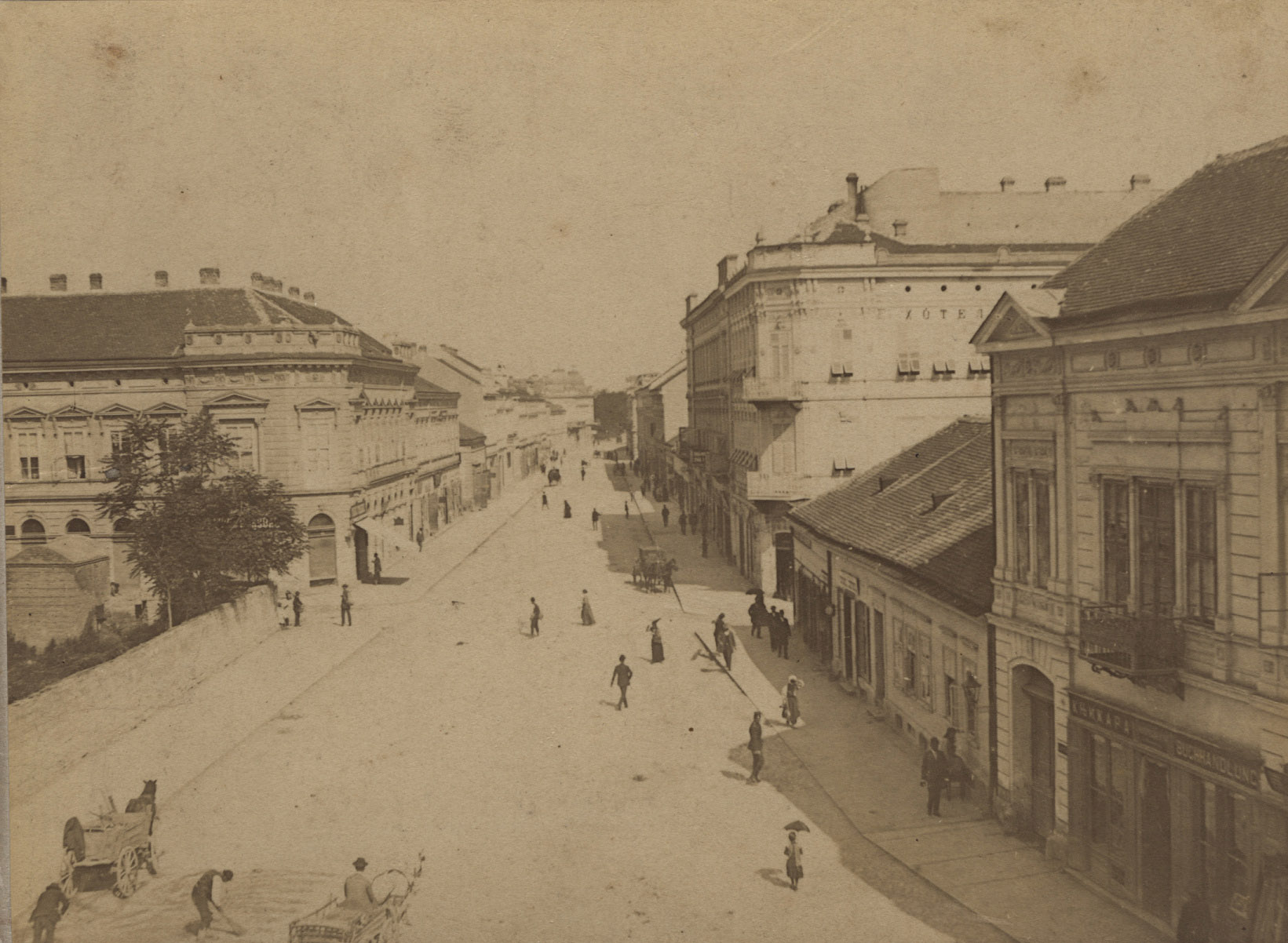
Photo via collection of the Belgrade City Museum courtesy of Miloš Jovanović.
The material transformation of Balkan cities was thus the local manifestation of a global process – indeed, it is this process which is reflected in aesthetic changes from Ottoman to European-style houses, the rise of hierarchical regimes of expertise that controlled construction labour and the new spatial arrangements of streets. These changes had a deep effect on how Balkan urban residents described modernity. It also set the terms upon which they understood urban change. If we are to draw parallels between post-socialist and post-Ottoman urbanization, as Belgrade’s contemporary authorities do, it is precisely these experiences of failure, the unequal terms through which urban modernity was implemented, which must be appreciated in their totality.
Local comprador elites seem to understand the reluctance of contemporary Belgraders to further embrace modernity. In a 2017 interview for the news agency Tanjug, city manager Vesić noted that opposition to construction ‘is simply part of the mentality. Every time something new is to be built which brings Belgrade closer to Europe, modernizes it, it is resisted by people who don’t see themselves in such things.’ Vesić further bolstered his argument by listing other examples of historic opposition to new construction projects in Belgrade across the twentieth century. The crux of Serbia’s dominant political economic ideology, which frames contemporary Belgrade as the apex of historical progress towards capitalist society, lay in his last example: Vesić cites the city’s first glass-covered department store, built in 1936, that had its windows broken soon after opening. During large protests, looters called for a national economy and used slogans against foreign capital.
Post-Ottoman, post-socialist
A year after the deaths of Šimunov and Dabetić, I came across a real-estate advert for a luxury apartment in the building from which the construction workers fell. Valued at 100,000 EUR for 23 square metres, the luxury housing is inaccessible to most Belgraders, whose median salaries hover at around two hundred and seventy euros a month. With a price three to four times higher than the city-wide average, the apartment was ideal for property owners aiming to profit from daily Airbnb and local website rentals. Indeed, this discrepancy challenges the popular opinion that prices reflect a relationship between supply and demand. The capitalist system seems unable to organize housing construction that satisfies the needs of Belgrade’s residents even less than its socialist predecessor.
From at least the 1970s onwards, the then Yugoslav State’s inability to provide an adequate supply of housing in rapidly growing urban centres worsened, leading to informal settlements appearing in Belgrade and its outskirts. Their construction, often on socially owned land, was leveraged by the State’s socialist promise of a right to housing. Even today, there are some 100 informal settlements in Belgrade, many of which occupy formerly socially owned property. Roma people and refugees from the Yugoslav wars – two of Serbia’s most socially marginalized groups, each considerably overlapping with the other – account for the majority of informal residents.
Since the mid-2000s, such settlements have been systematically and forcibly removed to make way for new construction or further ghettoize already-segregated groups. Despite Serbia’s various political upheavals, potentially profitable areas have been methodically cleared since the fall of Milošević. The first structured removals took place in two informal neighbourhoods known as Gazela and Belville in 2009 and 2012 respectively. In his analysis of the forced relocation of Gazela inhabitants, Konstantin Kilibarda describes how such processes satisfied ‘translocal needs of capital accumulation’, utilizing local muscle and EU funds to make way for the reconstruction of the Pan-European Corridor X. This highway and rail corridor from Salzburg to Thessaloniki with a branch to Istanbul is a major artery connecting Central Europe with the Middle East.
Few remember the Bara Venecija, the original name of the area where the Waterfront towers rise today. And yet Ciganska Bara was recorded as a Roma village from at least the seventeenth century. Prince Miloš’s nineteenth-century palaces were partly built by the forced labour of Belgrade’s Roma population. Palace walls were made of bricks produced in a nearby factory, where in June 1834 Roma, Serb and Turkish workers held what was most likely the first organized strike in Belgrade’s history. Now, Roma are increasingly displaced from Belgrade’s centre to make way for profitable luxury housing investments.
On election day, 24 April 2016, under the cover of night, para-state structures of dispossession crossed the ‘color line’ when masked men brutally demolished a non-Roma street to make way for the Waterfront project. Hercegovačka street’s destruction elicited concern from the European parliament and prompted a number of court cases but with little result. It also fuelled a mass protest movement led by ‘Ne da(vi)mo Beograd’, a right-to-the-city activist group. Protests resulted in the formation of a political party which competed in local elections yet failed to gain seats. In an eerie replay of Prince Miloš’s clearing of the Savamala district almost two centuries prior, petitions and protests remained unanswered. The construction project continued and demolitions proceeded at full pace.
Belgraders might have failed to stop the Waterfront project in part because its development is more than a local story. Indeed, the rise of luxury housing in Belgrade cannot be separated from other, larger global processes of dispossession. During the so-called ‘European migration crisis’ of 2015-6, Syrian, Iraqi and Afghan refugees on their way to Western Europe squatted abandoned houses awaiting demolition in the Savamala area. For many, Serbia was an inhospitable land. In Sokak, an online exhibition of photographs taken by people migrating along the Balkan route, 25-year-old Abdul from Afghanistan chose to portray himself bathing at -10∘C near the abandoned barracks that were demolished to make way for the Waterfront Central Park. ‘Winter in Belgrade is one of the hardest experiences of my life, and I have been beaten at the borders several times, they even broke my arm’, notes Abdul. Ultimately, refugees were evicted from many of the squats and subjected to random acts of terror by both the police and right-wing organizations. However, despite their precarious position, refugees also protested against the demolitions and created networks of solidarity in a nearby park.
Organizing solidary networks against predatory developments such as the Belgrade Waterfront is difficult in Serbia partly because negative social impacts are diffuse. Serbian organizers see the suffering of people on the Balkan route, the displacement of informal settlements and illegal evictions as separate issues.
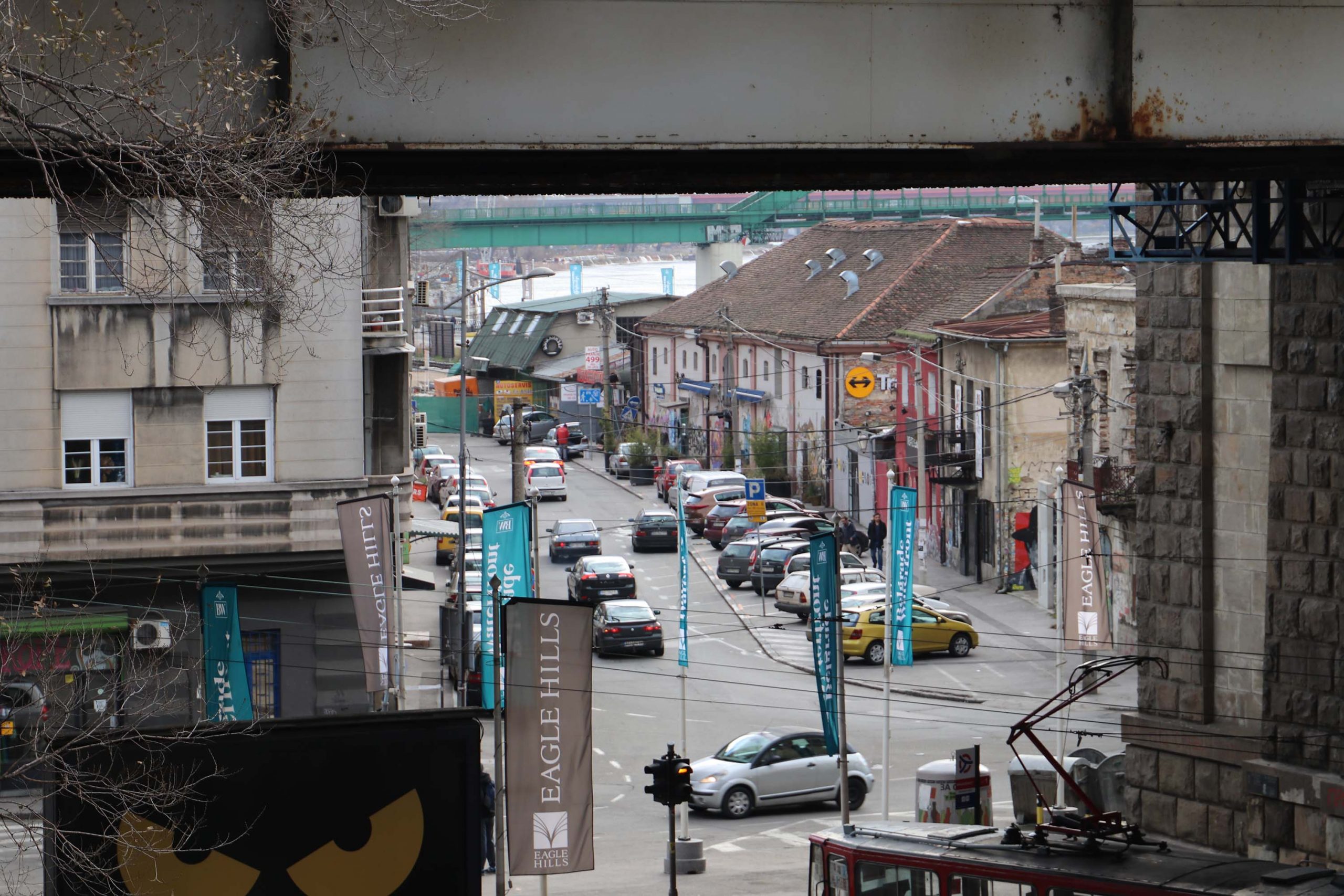
Banners advertising the Belgrade Waterfront in the Savamala district, December 2016. Structures near the back of the image have since been demolished. Photo by Miloš Jovanović (https://loshmi.net/en/film).
In 2019 Aleksandar Obradović, a whistleblower-employee of the Krušik weapons factory who was later imprisoned, revealed corrupt dealings in Serbia’s massive weapons exports to the Arab Gulf. The previous year, Serbia had exported 900 million dollars-worth of weapons, most of them to United Arab Emirates. These weapons were later traced to their ultimate destinations in Syria and Yemen. Eagle Hills, a UAE firm, is a key partner in the Waterfront project, whose development has risen concurrently with Serbia’s weapons exports. Mass deaths in the Global South lie congealed in the Waterfront towers’ glass and steel. The money behind its construction derives precisely from the exploitation of those who in fleeing have to sleep rough and evade the authorities under the shade of luxury housing.
Ongoing housing struggles in Belgrade primarily focus on the prevention of evictions for small debts, through the organization Krov nad glavom. According to news portal Mašina.rs, newly publicized laws on housing, financing the maintenance of apartment buildings, and enforcement and security ‘supply legal grounds to evictions even in cases where [a] primary home or a debt are a matter of an unresolved court case’. Like most of Eastern Europe after the transition from state socialism, Serbian homeownership remains very high, hovering at around 85%. Mass homeownership, one of the few benefits of privatization in the early 1990s, has produced a social cushion that prevents the expansion of capital accumulation in a number of spheres from informal labour to cheap housing. Struggles over evictions, as with earlier struggles over demolitions, are the Janus-face of Belgrade’s luxury developments. They form a terrain of resistance to new directions in urban accumulation with mixed results.
Luxury housing projects such as the Belgrade Waterfront rely on historical amnesia to weave their origin stories. Theirs is a narrative of progress that foregoes the tension and conflict upon which the present remains contingent. Six years after Prince Miloš’s burning of the Savamala, Franc Janke was sent to measure the alleys and streets of Palilula, the village where Savamalans resettled after their homes were burnt. City reports on Janke’s measurements speak of the collective resistance to urbanization conducted under the threat of new dispossessions. In April 1840 the Belgrade City government reported that: ‘Having begun to measure the streets at 37 meters width, the gentleman engineer realized that due to the wide streets, the residents’ plots should be taken and cut. For which reasons, that same people got very riled up, and the aforementioned gentlemen were exposed to the utmost dangers. To avoid this rebellion and unrest of the citizens, the gentleman engineer has found that the present plan for the alleys could be narrowed down.’ The narrow streets of Belgrade’s Palilula district remain as an archive of past struggles. Juxtaposed with narratives of progress, histories of resistance reveal that contemporary urban transformation is as unjust and futile as its nineteenth century precursor, always circumscribed by global hierarchies of power. Luxury housing in Belgrade is no exception.
This article is based on archival work for Waterfront: A post-Ottoman, post-socialist story (Germany/Serbia, 2018), a documentary film co-directed by Miloš Jovanović and the collective KURS (Miloš Miletić and Mirjana Radovanović). The author would like to thank the Dialoguing between the posts network for their comments on a presentation of this research in 2017.
